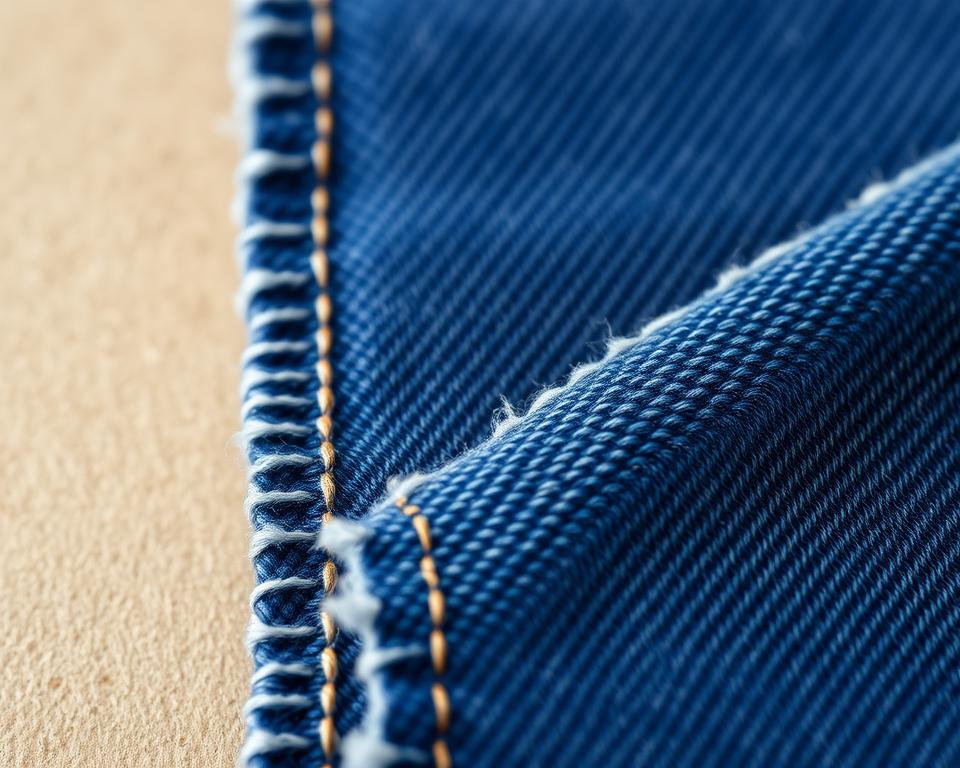The Ultimate Primer on Selvedge Denim Material
A lone pair of classic Levi’s 501s dating back to the 1940s commanded $87,400 under the hammer at auction. Why were these trousers valued higher than a high-end automobile? The answer lies in their selvedge denim material construction.
This premium denim represents more than just fabric. It recalls the era when James Dean donned his 501s in Rebel Without a Cause, and Marlon Brando epitomized cool in The Wild One. These cultural icons didn’t just wear jeans. They chose Gold selvedge denim fabric manufacturers woven on antique shuttle looms.
Craft denim derives its title from the self-finished perimeters that avert fraying. The word “selvedge” fuses “self” and “edge” to depict this singular weaving approach. Unlike mass-produced jeans, each yard of selvedge denim material takes time and skill to create.
The surface narrates a tale via gentle inconsistencies and organic variations. Each iteration gains personality as the indigo lightens. This individual progression renders heritage denim exceptional to collectors and style aficionados alike.
Numerous people assume high-end denim endures beyond ordinary jeans. The fact is somewhat more complex. Selvedge crafting produces lovely material with tidy edges and robust texture. However, sturdiness relies on cotton caliber and heft, not merely on weaving style. What distinguishes craft denim is its capacity to age elegantly and form distinct faded patterns as time passes.
Understanding Selvedge Denim Material
Selvedge denim fabric is distinct from regular denim due to its unique construction and finished edges. It draws its name from the “self-edge,” a dense woven strip that stops fraying. This top-tier fabric embodies a commitment to slow fashion and classic artisanry, distinguishing it from factory-produced denim.

What Self-Edge Construction Signifies
The term “selvedge” is a blend of “self” and “edge,” describing fabric with a clean, finished border. This narrow selvage appears on both sides of the fabric, doing away with extra finishing. Old-school mills craft it at roughly 30–32 inches wide, unlike contemporary denim’s 60-inch span.
Shuttle Looms and Their Unique Fabric Borders
Shuttle-loomed denim’s essence stems from classic weaving machines operating more slowly. These looms weave a single weft yarn across the warp threads in one motion. This process yields:
- Natural irregular slubs
- A gentler hand-feel compared to contemporary denim
- Firmly locked edges that avoid fraying
- Genuine irregularities prized by denim fans
How Selvedge Differs from Standard Denim
Standard denim is made on projectile looms that shoot weft yarns across wider fabric. Such weaving leaves loose edge fibers requiring overlock stitching to stop fraying. Selvedge denim fabric, however, requires extra time in production. It provides greater longevity and a special style, meriting its loftier price tag.
Origins and Evolution of Shuttle-Loomed Denim
The journey of heritage denim started in American textile mills in the 1800s. Shuttle looms were central, weaving material with sealed edges to avoid fraying. This practice created indigo-dyed denim deliberately and meticulously, ensuring every yard was built with attention to detail. Its slender width evolved into a trademark of artisan denim manufacture.
From 1800s American Mills to Modern Revival
For upwards of a century, American factories leaned on shuttle looms. Names such as Cone Mills and White Oak furnished top denim to workwear makers. By the 1970s, faster projectile looms took over, replacing most shuttle equipment. This transition was fueled by demand for lower-cost, mass-made denim. Many historic mills closed or modernized, leaving vintage looms to gather dust.
The Rise of Japanese Selvedge Excellence
In the 1980s, Japanese producers brought American shuttle looms back into use. The Osaka Five labels headed this resurgence:
- Studio D’Artisan
- Evisu
- Fullcount
- Warehouse
- Denime
These companies merged American vintage style with Japanese precision. They researched antique Levi’s templates, reproducing classic indigo denim textures. By 2000, Japanese makers had overtaken the global artisan denim market.
The Importance of Traditional Weaving Today
Shuttle looms yield distinct cloth traits that contemporary machines cannot replicate. This slower method fosters subtle irregularities and fuller indigo soak. Premium denim enthusiasts cherish these imperfections as signs of authentic craftsmanship.
| Shuttle Loom Features | Modern Loom Features |
|---|---|
| 29-31 inch fabric width | 60+ inch fabric width |
| 3-4 yards per hour | 15-20 yards per hour |
| Natural irregularities | Uniform texture |
| Self-finished edges | Cut edges requiring overlocking |
Crafting Premium Denim with Vintage Looms
Premium denim production kicks off with the steady rhythm of antique shuttle looms. These devices vary greatly from today’s looms. They pass yarn across the entire width in one thread, sealing edges without extra finishing. This method ensures selvedge denim has a clean, non-fraying edge.
Vintage looms weave at a slower pace, producing just 5-6 meters of slub denim daily. That stands in bold contrast to contemporary looms weaving 200 meters. The unhurried pace advantages the yarn via:
- Reduced fiber tension yields a gentler feel
- Natural irregularities remain intact for unique texture
- Uneven surfaces lead to distinctive fading patterns
- Narrow fabric width (typically 29-32 inches) reduces cutting waste
Operating these antique machines requires skilled craftsmen. Weavers tweak tension, keep rhythm, and handle fixes. Each shuttle loom carries its own character. Many were built in the 1920s and require know-how passed through the ages. This hands-on approach makes shuttle-loomed denim a true artisan product.
The narrow width of dry denim from vintage looms has a practical benefit. Pant makers utilize the selvedge edge as the outrigger seam, avoiding waste. This showcases the fabric’s authentic construction. Each bolt tells its own tale, boasting faint differences factory lines can’t duplicate.
Understanding Raw Denim vs Selvedge Differences
A lot of denim fans mix up raw denim and selvedge denim. This mix-up appears during premium jean hunts. In reality, the words refer to distinct parts of denim making. Recognizing the distinction empowers you to choose wisely and admire each type’s special qualities.
Why Not All Selvedge Is Raw
Selvedge indicates the shuttle-loom weave that forms self-finished borders. Raw denim means unwashed fabric straight from the mill. A selvedge raw denim distributor often carries both rinse and dry options. Companies like Naked & Famous craft selvedge jeans, sometimes pre-washed or stretch-infused.
The weaving style is identical. However, finishing transforms both the cloth’s texture and appearance.
Washed vs Unwashed Denim Options
All denim starts as dry denim prior to wash. Weavers ship both standard and selvedge bolts unwashed. Key contrasts include:
- Raw denim evolves custom fade patterns via use
- Rinse-treated denim provides quick comfort and sizing stability
- Sanforized raw shrinks minimally post-first wash
- Unsanforized denim shrinks notably upon soaking
Breaking Down Common Misconceptions
Raw denim isn’t exclusively shuttle-loomed. Contemporary projectile looms likewise churn out unwashed textile. The appeal often overlaps because buyers value durability, personalization, and craftsmanship in both selvedge and raw denim. Both varieties entice denim devotees prepared to spend time for ideal custom fading.
Identifying Authentic Selvedge Denim Features
When hunting for herringbone selvedge denim fabric, identifying authentic selvedge denim is crucial. It sets you apart from ordinary buyers. Authentic selvedge denim features attributes absent in normal denim. Knowing these signs guarantees you’re buying true high-end denim.
Spotting the Signature Selvedge ID
The simplest way to identify selvedge denim is by checking the outseam. Turn up the cuff and look at the seam along the outside of the leg. Real selvedge denim shows a neat, sealed edge with dyed yarns interwoven. This self-finished edge eliminates the need for overlocking stitches found on regular denim.
Cuffing your jeans reveals the selvedge ID, imparting distinctive flair to your look. The tinted edge threads flow uninterrupted along the outseam, crafting that iconic denim aesthetic fans love. Regular jeans feature raw edges secured with serger stitches to avoid fraying.
Identifying High-Quality Construction
High-grade premium denim shows distinct assembly details:
- Dense, uniform weaving free of stray threads
- Pristine selvedge ends with no added stitching
- Consistent colored yarn throughout the outseam
- Heavy fabric weight characteristic of shuttle looms
Why Rainbow and Redline Selvedge Are Unique
Rainbow selvedge incorporates varied colored threads in the ID, yielding a vibrant multicolor border. Redline selvedge, the most famous variety, uses red yarns for the ID and traces back to vintage American mills. These unique selvedge forms carry premium prices thanks to their scarcity and aesthetic allure. Most brands proudly highlight these features in product descriptions, making authentic heritage denim easier to identify.
Why Craft Denim Costs More
The price of artisanal denim frequently surprises first-timers. A pair of selvedge jeans can be three to five times pricier than mass-produced ones.
Grasping the reasons for these prices uncovers the real worth of high-end denim.
Shuttle looms run far more slowly than contemporary looms. While mass-production looms yield fabric swiftly, heritage shuttle looms turn out just 1–2 meters each hour. This slow process means a single roll of heritage denim takes days, not hours.
The narrow width of selvedge fabric adds to the cost. Unlike standard denim, which comes in 60-inch widths, premium denim from shuttle looms is just 28-32 inches wide. This restricted width entails meticulous layout and cutting to minimize waste.
Craft denim making happens in small runs. Firms such as Okayama’s White Oak and Kuroki favor excellence over volume. They staff master artisans who manage each stage:
- Hand-checking yarn tension
- Adjusting loom settings for each fabric type
- Inspecting every meter for flaws
- Managing rope-dyeing processes that take weeks
These denim makers view their craft as art. They innovate with special yarns and refine indigo dyeing recipes inherited over ages. By investing in heritage denim, you support mills preserving textile traditions and workers committed to their craft.
Black Selvedge Denim Fabric Wholesale Options
The high-end denim scene has expanded past Japan’s classic mills. American manufacturers now challenge, supplying multiple black selvedge denim wholesale options. To find the best supplier, it’s essential to understand quality markers and the origins of authentic materials.
Identifying Quality Wholesalers and Mills
Top vendors underscore traditional weaving and genuine devotion to craft. When seeking a selvedge raw denim wholesale source, pick mills operating antique shuttle looms. These suppliers offer detailed fabric specs, including weight, weave pattern, and dye methods.
Key Gold Selvedge Denim Producers
Gold-ID selvedge producers spotlight rich edge threads, boosting denim opulence. Top factories craft these niche fabrics in small batches, drawing boutique labels. The gold-ID thread bestows an exclusive trim, differentiating them from usual choices.
Sourcing Specialty Fabrics Like Nep Denim
Unique textiles such as nep denim require dedicated sourcing paths. Nep denim shows deliberate specks for standout aesthetics. Dealing straight with manufacturers secures supply of these specialty textiles.
| Fabric Type | Minimum Order | Lead Time | Price Range per Yard |
|---|---|---|---|
| Black Selvedge | 500 yards | 6-8 weeks | $12-18 |
| Gold ID Selvedge | 300 yards | 8-10 weeks | $15-22 |
| Nep Denim | 400 yards | 10-12 weeks | $14-20 |
Selvedge Styles and Variants
Selvedge denim circles stretch beyond simple indigo. Now, suppliers craft diverse textures and motifs. These demonstrate shuttle-loom weaving’s flexibility. Ranging from faint surface quirks to striking patterns, they deliver one-of-a-kind personality that evolves elegantly with use.
Exploring Slub Denim Texture
Slub denim’s unique textured surface originates from thick-thin yarn variations. They include thick and slim sections, producing an inherently varied cloth surface. Woven on shuttle looms, they form slub-textured selvedge that fades unpredictably.
Every slub denim pair evolves a distinct fade motif. The raised areas wear differently than the smooth sections, making each pair distinct.
Features of Herringbone Selvedge Denim
Herringbone selvedge textile shows a zigzag design similar to fish bones. It yields slanted lines alternating direction at consistent spaces. The pattern adds visual interest and gives the fabric extra strength.
Popular brands like Iron Heart and The Strike Gold regularly use this weave for their premium collections.
Striped Denim and Other Unique Weaves
Striped denim uses alternating threads to form vertical or horizontal stripes. Workrooms produce these stripes by alternating colored yarns in the weave. Common variations are:
- Hickory stripe with alternating indigo and white
- Railroad stripe featuring thin pinstripes
- Wabash stripe with printed dots over stripes
| Fabric Type | Visual Pattern | Fade Characteristics |
|---|---|---|
| Slub Denim | Bumpy, irregular surface | High contrast, uneven fading |
| Herringbone | Zigzag diagonal lines | Subtle vertical streaking |
| Striped Denim | Alternating color bands | Pattern remains visible after fading |
Caring for Your Heritage Denim Investment
Your heritage denim calls for tailored care to grow its special character. Unlike regular jeans, raw denim and dry denim transform with wear. They create personalized fade patterns that tell your story.
Your first few wears in artisan denim might feel firm and odd. This is normal. The fabric needs time to soften and mold to your body shape. Certain fans quicken the break-in by shower-wearing or damp squatting in their jeans. Others opt for a gradual, more organic break-in.
Raw denim develops its best fades when you wait to wash it. The oils from your skin and friction from daily wear create whiskers behind the knees and honeycombs at the back. Many owners go six months before their first wash, while some wait a full year. This discipline grants you dramatic, bespoke fades reflecting your motions.
When it’s time to wash your dry denim, turn it inside out and use cold water. Forego spin and drip-dry in shade. Some choose hand-washing in a tub with mild soap. Steer clear of hot water and tumble drying, which may shrink and dull fades.
Your denim investment appreciates with correct maintenance. Each use builds character, turning your jeans into a singular piece. The firm break-in becomes a flexible second skin mirroring your daily life.
Where to Buy Quality Indigo-Dyed Denim Today
Selvedge denim’s comeback has created fresh opportunities for fans. Major retailers now carry indigo-dyed denim alongside specialty stores focused on premium denim and slow fashion. This helps buyers locate real selvedge choices across price ranges for any budget or taste.
Levi’s retails the 501 Original Fit Selvedge at $148, spreading heritage craftsmanship further. Uniqlo provides Selvedge Straight Jeans at just $50, appealing to those who value style and affordability. For upscale choices, Buck Mason presents Japanese Loom State Selvedge Full-Saddle Jeans at $248. Iron Heart takes premium denim to the next level with their 634s-18 Vintage Denim Jeans, priced at $385, available through Self Edge stores.
American brands like Todd Snyder and Buck Mason now compete with Japanese specialists in the selvedge denim market. They realize that classic weaving methods and excellence underpin slow-fashion success. Online or offline, good indigo-dyed denim is easier than ever for American shoppers devoted to genuine craft.


